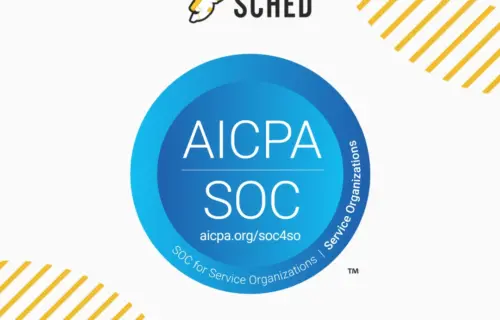Key Takeaways:
Table of contents
- 1 Key Takeaways:
- 2 What’s Worth Keeping in Your School Event Tech Stack?
- 3 What Your School Should Replace (Because It’s Creating More Work Than It Saves)
- 4 What an Effective School Event Tech Stack Looks Like in 2025
- 5 How to Try New Tech Without Overwhelming Your School Staff
- 6 How You’ll Know It’s Working: Look for These Results
- 7 Spend Less Time Coordinating And Plan Better K-12 School Events With Sched
- Disconnected tools slow down event planning and create more manual work for your team.
- Some tech is worth keeping when it fits into a bigger system.
- Tools not built for education events often add extra work.
- Having one central platform for your school events helps you save time, reduce errors, and plan events with more confidence.
Schools think planning better events means getting more tools. But what if that’s exactly what’s making things harder?
Google Forms. Spreadsheets. Email threads. They worked when you only had one building or one small event a year. But those tools were never built to run districtwide PD or parent-teacher nights at scale.
The more you try to stitch them together, the more time your team spends just keeping things functional: staff hunting down schedule changes, parents missing updates, rooms getting double-booked, and organizers left exhausted.
The good news is you probably don’t need to buy more tech, you just need to rethink which tools are helping, and which ones are quietly causing most of the chaos.
Let’s break down how to rebuild a smarter, simpler school event tech stack.
What’s Worth Keeping in Your School Event Tech Stack?
Not everything needs to go. Before we talk about what to replace, let’s look at the tools that are actually helping.
A lot of schools already use familiar systems that work just fine when they’re connected to something bigger. These tools don’t need to be tossed out. They just need to be part of a smarter system.
Here are the most common tools schools use that are still worth keeping, if used wisely:
1. Google Classroom or Canvas (LMS tools)
Keep for sharing workshop materials, pre-event resources, and session content. These platforms are already familiar to staff and can extend the value of your events beyond the day-of.
2. Your School Website or Portal (e.g., Blackboard, Finalsite).
Still your most important source of truth for families. Just make sure it links to real-time updates and doesn’t require constant manual edits when the event changes.
3. Mailchimp or Gmail for Communication.
If you’re already using email marketing or direct mail tools, they’re worth keeping, as long as they can integrate with your registration or event software and support automated, segmented sends.
4. Facebook, Instagram, or Twitter/X.
Still great channels for community engagement and visibility, especially for family-focused events or public invitations.
Keep in mind that all these tools work best when they’re part of a bigger, connected system that allows for automation.
What Your School Should Replace (Because It’s Creating More Work Than It Saves)
In most K–12 schools, event tools weren’t chosen, they just accumulated over time. What started as a few helpful tools often becomes a tangled web that slows down planning and overwhelms staff.
Here are the most common culprits and what to use instead:
1. Google Forms for RSVPs and Feedback
While it’s free and familiar, Google Forms lacks session-level tracking, secure data management, and real-time analytics. Replace it with a built-in registration and feedback system that connects to your event schedule and attendee database.
2. Excel or Google Sheets for Tracking Schedules and Attendees
Spreadsheets are prone to errors, tough to update in real-time, and hard to share without version control issues. Use a dedicated event dashboard that updates automatically and provides a live view of attendance and session capacity.
3. Group Email Threads and One-Off Messages
Email chains get buried and missed. Switch to a communication system built into your event platform that supports scheduled updates, real-time alerts, and role-based messaging (e.g., attendees, presenters, volunteers).
4. Paper Registration and Sign-In Sheets
They’re hard to manage and impossible to scale. QR code check-in tools reduce bottlenecks and improve data accuracy instantly.
5. Standalone Payment Apps (like Venmo or Square)
These tools may work in a pinch but aren’t built for school needs or multi-tiered event ticketing. Use a school-friendly payment processor that integrates directly with your event platform and tracks purchases by attendee type.
6. Google Docs for Post-Event Reports
Manually compiling insights from different tools is time-consuming and rarely complete. Replace this with exportable reports generated directly from your event platform, covering attendance, feedback, and engagement at a glance.
If your team is spending more time copying data between tools than planning the actual event, your stack is working against you.
What an Effective School Event Tech Stack Looks Like in 2025
A modern event stack doesn’t mean adding more tools to your plate, it means connecting the right ones around a single system that works the way your school team does. A smarter stack helps every role spend less time managing logistics and more time making events meaningful.
Here’s what that looks like:
1. A Core Event Platform (Like Sched)
This is the foundation of your tech stack: a centralized tool to manage event logistics from start to finish.
With school event management software, you can:
- Plan districtwide PD, school-wide conferences, or community events from one place.
- Manage sessions, speakers, and time slots with real-time visibility.
- Handle registration, ticketing, QR check-ins, and attendee tracking without spreadsheets.
- Automate reminders and follow-ups to reduce no-shows.
- Generate reports for post-event insights, board reports, or PD evaluations.
- Integrate with your SIS or LMS to eliminate double data entry.
- Collect and review session proposals with built-in workflows (no more Google Forms).
- Ensure accessible event schedules and mobile experiences for all users.
2. Communication & Engagement Tools
Once your foundation is set, the next layer is communication; ensuring that attendees, staff, and volunteers stay informed and engaged before, during, and after the event with:
- Centralized messages and event updates via email, SMS, app notifications.
- Event apps with personalized schedules and session reminders.
- Feedback surveys and polls to collect insights while the experience is fresh.
- Share session slides, links, and resources in one accessible place post-event.
3. On-Site Logistics Tools
Smooth day-of operations depend on having the right tools on the ground:
- Mobile-friendly check-in kiosks that speed up arrivals.
- Reliable Wifi and up-to-date AV equipment for presentations.
- Payment terminals for concessions, merch, or fundraising.
- Livestreaming to support hybrid access and remote participants.
- Assign and coordinate event-day staff or volunteers with clear task visibility.
4. Analytics & Security
The final layer of a future-ready stack is about measuring what worked, protecting data, and using insights to improve your next event by having:
- Real-time dashboards showing attendance and engagement trends.
- Exportable reports to support funding proposals or board reviews.
- Secure data protection for staff and students.
Depending on your event size, some tools may be optional. Start with your core system, then layer on only what your team needs.
How to Try New Tech Without Overwhelming Your School Staff
Worried about a bumpy transition? That’s completely normal. And it’s why many schools start small by:
- Auditing your current tools: What’s working? What’s not?
- Picking a priority: Is time-saving more important than reporting? Are communication issues your main struggle?
- Starting small: Test a new platform on a single event before rolling it out district-wide.
After you’re comfortable with the software, you can start enhancing the experience by adding mobile app access, automating communications, and using analytics to improve future events.
WEMTA, a long-running educator association, has used Sched for over 10 years to run complex, multi-day conferences, without needing multiple tools or complicated workflows.
A thoughtful, phased approach helps your team build confidence and ensures long-term adoption.
How You’ll Know It’s Working: Look for These Results
A better tech stack should make a difference you can see and measure:
- Event setup time: What used to take hours now takes 30 minutes.
- Error reduction: No more double-booked rooms or missed messages.
- Staff hours saved by automating reminders, check-ins, and surveys.
- Higher participation in your events.
Spend Less Time Coordinating And Plan Better K-12 School Events With Sched
When event tech supports your team, everything gets easier. Your staff saves time on admin tasks, attendees get clear, timely information, and you gather insights to improve future events.But most importantly, educators spend more time connecting with their communities, and less time managing logistics. Sched helps schools with big and small events, so your team has one tool to rely on each time. Try Sched for free for your next event.








